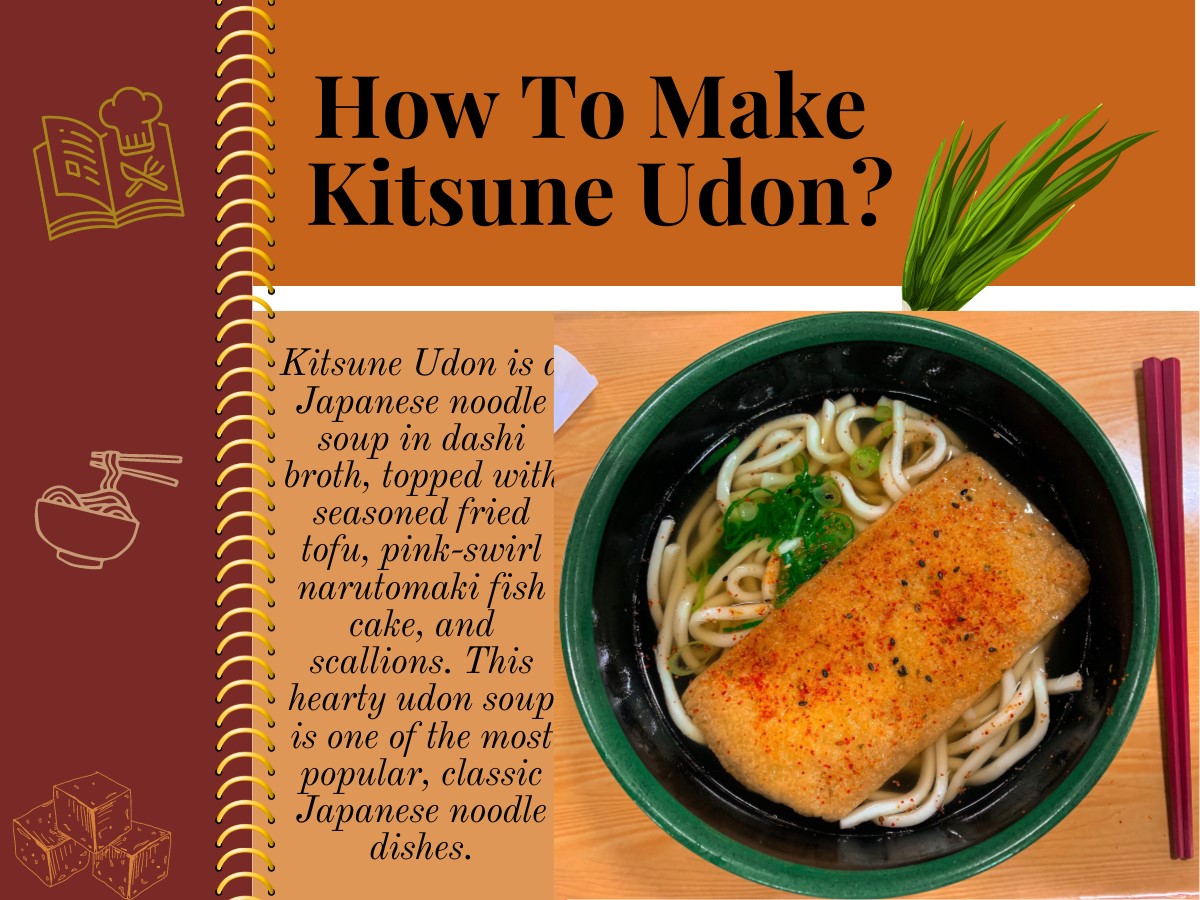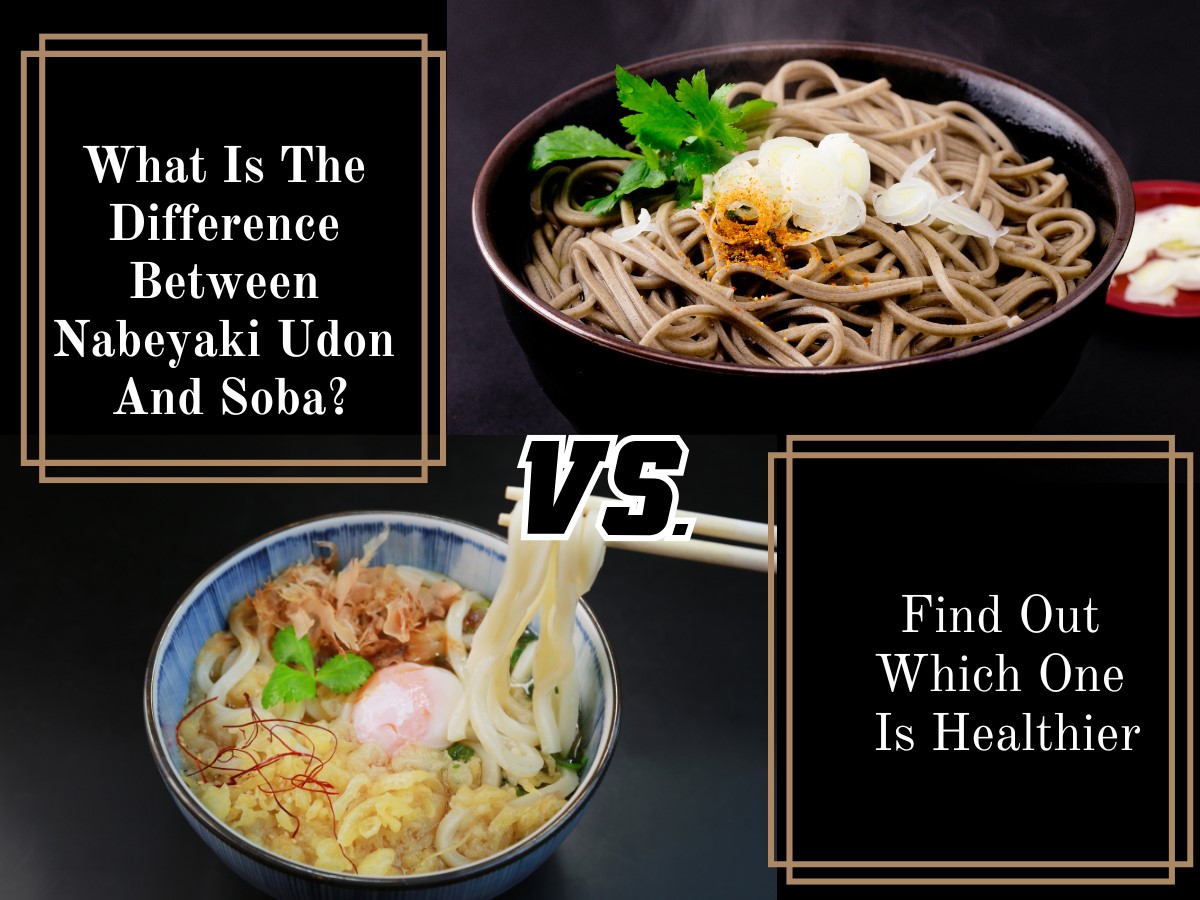Kitsune udon is a classic Japanese meal comprising a warming and soothing udon noodle soup. It is topped with fried tofu and narutomaki fish cake, perfectly seasoned with soy sauce, mirin, umami-rich dashi, and shichimi togarashi, a special Japanese spice mix. In this Kitsune udon recipe, the simmering hot broth, crispy fried tofu, and chewy noodles all blend to make an incredibly delectable and satiating meal. Indeed, it’s best for breakfast, lunch, dinner, and supper. You can have it in summer as well as in winter to reinvigorate your body and soul. The following Kitsune udon recipe concerns “How to Make Kitsune Udon?”, its nutritional value, and serving options; you must try it.
Table of Contents:
- What is Kitsune Udon?
- Is Kitsune Udon Healthy?
- Nutritional Value of Kitsune Udon
- Is Kitsune Udon Vegan?
- Key Ingredients of Kitsune Udon
- How to Make Kitsune Udon?
- Ingredients
- Step-by-Step Recipe
- How to Serve Kitsune Udon?
- FAQs
- Wrapping Up
What is Kitsune Udon?
Kitsune literally means fox, which is why this noodle soup is called “fox udon,” according to obsolete Japanese theories. One claims that since deep-fried tofu was the preferred diet of the fox in their folktales, some early people began referring to it as kitsune. Still, another theory says that the color of aburaage was similar to the fox color; hence this dish was named kitsune udon.
Kitsune udon is an Udon noodle soup made with umami-rich dashi, delicious fried tofu, and pink-swirl narutomaki fish cake. The chewy-gooey udon noodles perfectly pair with crunchy aburaage and balmy soup. You can have this delectable meal in any Japanese restaurant and cook it yourself following the Chef-secret kitsune udon recipe and tips.
Is Kitsune Udon Healthy?
Yes, kitsune udon is a nourishing and reinvigorating meal since it’s a blend of whole-wheat udon noodles, dashi stock, narutomaki fish, and protein-rich tofu. Since the hero of the meal is deep-fried tofu, you must know how healthy the tofu is. It is made by coagulating soy milk, a rich protein source that contains all nine essential amino acids the human body cannot naturally forge. Moreover, tofu contains numerous minerals and vitamins vital to normal human functioning. In addition, dashi, which is a blend of dried bonito flakes and kelp, is hearty and wholesome.
Narutomaki fish cake with pink swirl, one of the traditional toppings of kitsune udon, is also a healthy and nutritive component. It is enriched with proteins and contains a very low proportion of carbohydrates and no fats. Moreover, you only get less than seventy calories per narutomaki fish cake serving. Also, whole-wheat udon noodles are rich in dietary fiber and contain less proportion of simple carbs and a negligible amount of fats. Therefore, these are easy to digest and are low on the stomach.
It’s crucial to know that udon noodles are healthy as soon as you keep them in an agreeable portion and balance them conscientiously with proteins. You can choose the proteins depending on whether you want vegan-style kitsune udon or a non-vegan kitsune udon meal. In a nutshell, add katsuobushi for a non-vegan style and kombu with or without shiitake mushrooms to get plant-based proteins.
Nutritional Value of Kitsune Udon
The statistics regarding kitsune udon’s nutritional information is listed below. Moreover, the portion size of nutritional components is calculated per serving.
| Nutritional Components | Amount per serving |
| Protein | 17.31 grams |
| Total Fats | 10.9 grams |
| Total Carbohydrates | 68.24 grams |
| Sodium | 2754.7 milligrams |
| Potassium | 243.66 milligrams |
| Magnesium | 82.4 milligrams |
| Calcium | 123.4 milligrams |
| Phosphorus | 206.1 milligrams |
| Copper | 0.18 milligrams |
| Manganese | 0.73 milligrams |
| Iron | 2.47 milligrams |
| Zinc | 1.37 milligrams |
| Chromium | 2,38 micrograms |
| Molybdenum | 5.68 micrograms |
| Selenium | 4.81 micrograms |
Is Kitsune Udon Vegan?
Yes, kitsune udon can be vegan. However, traditionally it is made with dried bonito flakes, a fish. You can make kitsune udon vegan by replacing katsuobushi (dried bonito flakes) with kombu, edible kelp. Moreover, adding stir-fried vegetables and shichimi togarashi can balance the savoriness and umami flavor of vegan kitsune udon. It’s crucial to add plant-based protein sources to your meal to counterbalance the benefits of udon noodles.
Key Ingredients of Kitsune Udon
Dashi Stock
A toothsome and warming dashi stock is the main element of kitsune udon. It can be produced from scratch, dashi instant powder, and packets. Nevertheless, the most nourishing and healthy method is to make your dashi stock from scratch. It will only take about 20 minutes. Moreover, you can prepare dashi soup from a dashi packet containing all the dried ingredients. However, you should not prefer instant dashi powder since it will not make your meal delectable and nutritive.
Aburaage
Aburaage, the deep-fried tofu pouch, is available in Japanese or Asian stores. So you can buy them from the market and prepare them at home. Remember that homemade foods are more delicious and healthy since they are devoid of preservatives, artificial flavors, and chemicals.
Udon Noodles
Since udon noodles are highly well-liked outside of Japan, anyone living elsewhere can still get them from Asian markets. There are wide varieties of noodles, but udon noodles perfectly balance the umami flavor and savoriness of kitsune udon.
How to Make Kitsune Udon?
Do you want to make kitsune udon like a Pro enriched with savoriness and aroma? Try this recipe to get a mouthwatering and nutritious meal.
Ingredients
For Kitsune Udon Noodles:
| Udon noodles | Two packets; 180 grams |
| Inari age (seasoned and fried tofu | 4 |
| Narutomaki fish cakes | 4 |
| Green onions | 1 |
| Shichimi togarashi | As required |
For Homemade Dashi Recipe:
| Water | 2 ½ cups |
| Katsuobushi (dried bonito flakes) | 1 ½ cups |
| Kombu (dried kelp; seaweed) | 1 |
For Soup Broth
| Dashi Soup Stock | 2 ½ cups |
| Usukuchi Soy sauce | one tablespoon |
| Mirin | one tablespoon |
| Sugar | One teaspoon |
| Kosher salt | ½ teaspoon |
Step-by-Step Kitsune Udon Recipe:
- Gather all ingredients for a mess-free cooking experience.
- Firstly, to make homemade dashi stock, soak the kombu in the water for about half an hour. You can also soak this kelp for half a day before cooking. Nevertheless, if you wish to make it right away, put the kombu in the water and simmer it for 15-30minutes but do not reach boiling. Remove the kombu, and your vegan dashi stock is ready. For the non-vegan recipe, after removing the kombu, add katsuobushi and boil it. After boiling, let the stock simmer for another 15 minutes. Then, strain the stock, and it is ready to use.
- For a soup broth, take a large pot and add prepared dashi stock. Then, add mirin, soy sauce, sugar, and kosher salt. Bring it to a boil, turn off the flame and let it simmer for five minutes with the lid on.
- For udon noodles, take a large pot and add water. Add the cake of frozen udon noodles and boil them in hot water for about a minute. Strain them and put them in a bowl for later use. You can also use dry noodles and follow the labeled steps to cook them accurately.
- Lastly, prepare the garnishings. Finely chop fresh green onions and cut narutomaki fish cake into thin slant slices. Firmly press the aburaage to squeeze out excess moisture. Season the tofu and fry them to golden brown perfection.
- Put the dashi stock soup in a bowl, aburaage, narutomaki fish cake slices, and udon noodles. Then dip a sauce over them and add shichimi togarashi for extra savoriness and spice. Serve it hot.
How to Serve Kitsune Udon?
You can serve kitsune udon with deep-fried tofu and narutomaki fish. Moreover, season it with soy sauce and shichimi togarashi to get a perfect blend of flavors. Serve it hot, and enjoy the hearty noodle soup.
FAQs
What is Udon?
The term “Udon” is used for Japanese noodles made of whole wheat with a glossy white appearance and mild flavor. These are the star ingredients of many Japanese meals, such as Kitsune udon, tempura udon, Kake udon, tonkatsu udon, and nabe yaki udon. Moreover, udon noodles are most loved when served with dashi stock, poached eggs, fried tofu, seafood, and soy sauce.
What Does Kitsune Udon Taste Like?
Kitsune udon has a rich umami and savory flavor, which is balanced with the mild flavor of udon noodles and the sweetness of tofu.
How to Store Kitsune Udon?
Kitsune udon can last in the refrigerator for about three days. Since the recipe contains fish, it is advisable to consume it fresh and as soon as possible. Store the package in an air-tight container to prevent it from getting soggy and moist.
Wrapping Up
Kitsune udon is a nutritive classical Japanese delicacy made with umami-rich dashi soup, mildly flavored udon noodles, and seasoned deep-fried tofu. The savoriness of the dish is enhanced with the Japanese spice mix and dipping sauces. For an authentic kitsune udon recipe and its nutritional value, refer to the above content.
Also Read: How Healthy Is Agedashi Tofu? Nutritional Facts and Recipe





